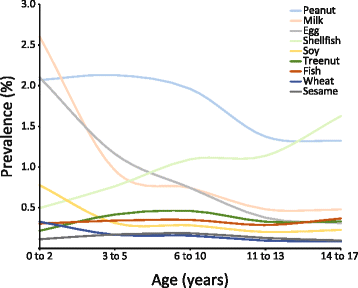The epidemiologic characteristics of healthcare provider-diagnosed eczema, asthma, allergic rhinitis, and food allergy in children: a retrospective cohort study
- PMID: 27542726
- PMCID: PMC4992234
- DOI: 10.1186/s12887-016-0673-z
The epidemiologic characteristics of healthcare provider-diagnosed eczema, asthma, allergic rhinitis, and food allergy in children: a retrospective cohort study
Abstract
Background: The rates of childhood allergic conditions are changing, prompting the need for continued surveillance. Examination of healthcare provider-based diagnosis data is an important and lacking methodology needed to complement existing studies that rely on participant reporting.
Methods: Utilizing our care network of 1,050,061 urban and sub-urban children, we defined two retrospective cohorts: (1) a closed birth cohort of 29,662 children and (2) a cross-sectional cohort of 333,200 children. These cohorts were utilized to determine the epidemiologic characteristics of the conditions studied. Logistic regression was utilized to determine the extent to which food allergy was associated with respiratory allergy.
Results: In our birth cohort, the peak age at diagnosis of eczema, asthma, rhinitis, and food allergy was between 0 and 5 months (7.3 %), 12 and 17 months (8.7 %), 24 and 29 months (2.5 %), and 12 and 17 months (1.9 %), respectively. In our cross-sectional cohort, eczema and rhinitis prevalence rates were 6.7 % and 19.9 %, respectively. Asthma prevalence was 21.8 %, a rate higher than previously reported. Food allergy prevalence was 6.7 %, with the most common allergenic foods being peanut (2.6 %), milk (2.2 %), egg (1.8 %), shellfish (1.5 %), and soy (0.7 %). Food allergy was associated with development of asthma (OR 2.16, 95 % CI 1.94-2.40), and rhinitis (OR 2.72, 95 % CI 2.45-3.03).
Conclusions: Compared with previous reports, we measure lower rates of eczema and higher rates of asthma. The distribution of the major allergenic foods diverged from prior figures, and food allergy was associated with the development of respiratory allergy. The utilization of provider-based diagnosis data contributes an important and lacking methodology that complements existing studies.
Keywords: Allergic rhinitis; Asthma; Eczema; Food allergy; Prevalence.
Figures
References
-
- Bloom B, Jones LI, Freeman G. Summary health statistics for U.S. children: National Health Interview Survey, 2012. Vital Health Stat 10. 2013;258(258):1–81. - PubMed
-
- Akinbami LJ, Moorman JE, Bailey C, Zahran HS, King M, Johnson CA, Liu X. Trends in asthma prevalence, health care use, and mortality in the United States, 2001-2010. NCHS Data Brief. 2012;94(94):1–8. - PubMed
-
- Jackson KD, Howie LD, Akinbami LJ. Trends in allergic conditions among children: United States, 1997-2011. NCHS Data Brief. 2013;121(121):1–8. - PubMed
Publication types
MeSH terms
LinkOut - more resources
Full Text Sources
Other Literature Sources
Medical



